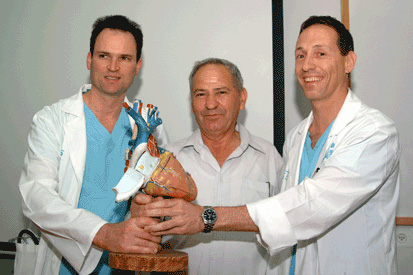To Aspirin or Not To Aspirin

from the left: Prof. Ran Kornowski, patient Amos Ben Yosef, Dr. Shmuel Fuchs
by Ran Kornowski (article appears courtesy of www.haaretz.com)
One of the most common questions to cardiologists when they examine a patient is, "Should I take aspirin?" This is a relevant question since the main cause of serious conditions in the heart, blood vessels or other bodily organs is blood clots that develop on a sclerotic level rich in cholesterol located on the walls of blood vessels. Aspirin is given as a medication to "thin" the blood and prevent the clotting process. It hinders the blood corpuscles responsible for creating the clot. However, along with the ability to prevent clotting in the blood system, taking aspirin does somewhat increase the chances of hemorrhages.
All the research studies taken together (until the current study) have covered approximately 95,000 patients, divided about equally into those who were treated with aspirin and a control group. The follow-up covered four to 10 years. The risk of a serious incident involving blood vessels (in the heart, brain or other organ) was found to be smaller by 12 percent than in the control group; the risk of a heart attack was less by 15 percent. The effect of aspirin on the chances of a stroke was not significant, and the overall mortality rate was the same in both groups.
Among the group of patients who took aspirin a higher rate of hemorrhaging was observed, mainly in the digestive system (0.1 percent among patients treated with aspirin as compared to 0.07 percent of the control group for a year of treatment). In patients who had already had incidents in the blood vessels of the heart or brain, the effect of the aspirin ("secondary prevention") was far more positive and dramatic.
In contrast to what has been said above, the latest research study has found that administering aspirin at a low dosage to healthy people with proven sclerosis of the blood vessels but without symptoms of heart disease is ineffective.
The study was carried out in Scotland on 3,550 participants with medium to high risk of a serious incident in the blood vessels. In examinations of the participants there were findings that showed they had already developed clogging of the arteries in their legs. The researchers followed the participants for 8.2 years on average and examined how many of them suffered a cardiac incident or a stroke, or needed a catheterization or bypass surgery.
t was not found that the group treated with aspirin developed fewer cardiac incidents or stokes than the group that received a placebo. Among the total group there were 357 incidents - 181 of them among patients who had received aspirin (10.8 percent) and 176 in the placebo group (10.5 percent).
However, the study did find a connection between treatment with aspirin and higher risk of significant and life-threatening hemorrhaging (2.0 percent in the aspirin group as compared to 1.2 percent in the placebo group). Most of the hemorrhages were in the digestive system.
How is it possible to bridge the gap between these findings and the earlier data? In this context it is necessary to note a number of significant limitations in the current research. First of all, among 40 percent of the patients there was low cooperation with the treatment and they did not take the aspirin properly during the period of the study. Secondly, it is possible that the research population was not large enough to evaluate primary prevention of heart disease. Finally, it is possible that aspirin is not the medication that should be preferred for patients who suffer peripheral disorders of blood vessels in their legs. It would seem that these patients respond better to treatment with other blood thinners, such as Plavix.
Despite the doubts raised by the study, the existing recommendations regarding aspirin treatment for people at greater risk of developing heart and blood vessel diseases have not changed. The medical community is still studying the research. It will be some time before conclusions are formulated.
The common treatment recommendation is relevant for patients 45 to 60 in whom there are significant risk factors for developing sclerotic heart disorders, and who have a 10 percent risk of a heart attack in the decade following the diagnosis.
In this context it is important to note that the decision concerning preventive administration of aspirin must be taken after weighing the efficacy of the treatment against the potential risk it entails. The doctor will consider the administration of preventive treatment positively if there are at least two significant risk factors for the development of heart disease, and there is no medical problem because of which aspirin should not be used. It is very important to understand that taking aspirin should be seen as part of a broader preventive strategy entailing changes in life habits. Other parts of this strategy are regular physical activity, healthy nutrition and weight loss, stopping smoking, balancing blood pressure and balancing diabetes.
It must be taken into account that many people are in the gray area, and even after a comprehensive assessment it is impossible to determine conclusively whether preventive treatment with aspirin is indeed desirable for them. In these cases it would seem that the latest study will have the greatest effect, and is likely to tip the balance against treatment.
The author is head of the cardiac catheterization unit at Rabin Medical Center, Beilinson Hospital and the Sackler Faculty of Medicine, Tel Aviv University
Related Articles
Rabin Medical Center Performs Israel's First Mitral Valve Implant Via Catheter
Fewer than 20 such operations have been performed anywhere!
by JUDY SIEGEL-ITZKOVICH, Jerusalem Post
Heart Surgery: Now Less Invasive
Recent decades have witnessed a clear trend toward less invasive medical procedures, especially in cardiac surgery.
Rabin Medical Center Department of Cardiothoracic Surgery
The Rabin Medical Center Department of Cardiothoracic Surgery is one of the oldest such departments in the country, initially established in 1951.